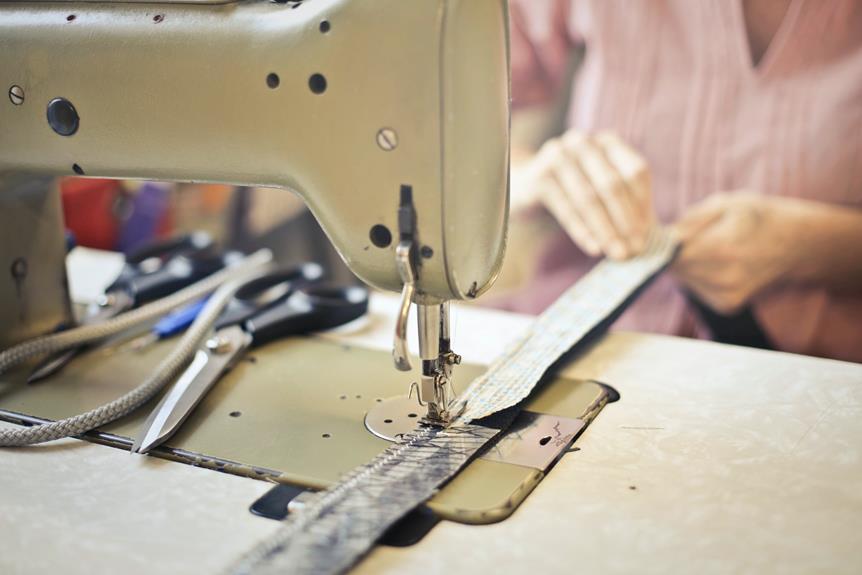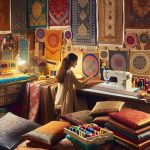Are you ready to unlock the hidden potential of your fabric crafting? Superimposed seams hold the key to achieving flawless, professional-quality results.
In this brief exploration, we will delve into the secrets of superimposed seams and their transformative impact on your fabric projects. With a keen eye for detail and a commitment to precision, you can elevate your craftsmanship to new heights.
By understanding the intricacies of this technique and implementing it with finesse, you will witness a remarkable improvement in the quality and durability of your creations.
Get ready to master the art of superimposed seams and take your fabric crafting to the next level.
Key Takeaways
- Superimposed seams allow for intricate designs and textures without adding bulk to the fabric.
- They enable seamless connections between different types of fabric.
- Precise stitching and alignment of seam allowances are essential for a clean and professional look.
- Superimposed seams enhance design flexibility, maintain consistent seam allowances, and provide a seamless and polished finish.
Understanding Superimposed Seams
You may be wondering what superimposed seams are and how they can improve your fabric crafting. Superimposed seams involve joining two pieces of fabric with their seam allowances on top of each other, creating a smooth and flat finish. This technique is especially useful in fabric manipulation, as it allows for intricate designs and textures without adding bulk to the fabric.
Understanding superimposed seams is crucial for mastering various fabric manipulation techniques. By utilizing this method, you can create visually appealing patterns and textures while maintaining the integrity and drape of the fabric. Additionally, superimposed seams enable you to connect different types of fabric seamlessly, expanding the possibilities for your crafting projects.
Mastering the art of superimposed seams involves precise stitching and attention to detail. It's essential to carefully align the seam allowances and secure them in place to achieve a clean and professional look. By incorporating this technique into your fabric crafting repertoire, you can elevate your projects and explore new avenues for creativity in fabric manipulation.
Advantages of Superimposed Seams
The advantages of superimposed seams in fabric crafting are numerous, offering enhanced design flexibility and a seamless finish. By utilizing superimposed seams, you can manipulate fabric in innovative ways, creating visually stunning and structurally sound pieces. One of the key benefits is the ability to maintain a consistent seam allowance throughout the crafting process, ensuring precision and uniformity in the final product. Additionally, superimposed seams enable intricate fabric manipulation, allowing you to experiment with textures, pleats, and folds to elevate the visual appeal of your creations. This technique empowers you to craft intricate designs with a professional touch, as it provides a seamless, polished look while enhancing the durability of the crafted item. Below is a table summarizing the advantages of superimposed seams in fabric crafting:
| Advantages of Superimposed Seams | ||
|---|---|---|
| Enhanced Design Flexibility | Consistent Seam Allowance | Innovative Fabric Manipulation |
| Seamless Finish | Professional Polished Look | Durability and Structural Integrity |
Techniques for Superimposed Seams
Superimposed seams are achieved by overlapping and stitching fabric layers together, ensuring a neat and secure join. To execute this technique with finesse, you'll need the right sewing tools. A sharp pair of fabric scissors is essential for precise cutting, while fabric weights or pins can help keep the layers aligned during sewing. Additionally, a quality sewing machine with adjustable stitch length and a walking foot can make the process smoother.
Fabric manipulation plays a crucial role in achieving impeccable superimposed seams. Techniques such as understitching, edge stitching, and topstitching can help secure the layers and add a professional finish to your fabric crafting projects. Understitching involves stitching the seam allowance to the facing or lining fabric, preventing it from rolling out and creating a clean edge. Edge stitching and topstitching add decorative and functional elements, emphasizing the superimposed seams and providing extra reinforcement.
Mastering these techniques and utilizing the right sewing tools for fabric manipulation will elevate your craft, resulting in seamless and polished superimposed seams.
Tips for Perfecting Superimposed Seams
To achieve perfect superimposed seams, use precise stitching techniques and the right tools. When sewing superimposed seams, it's crucial to pay attention to your stitching techniques. Use a smaller stitch length to ensure accuracy and stability in the seam. This helps to prevent the fabric from shifting and creates a neat, professional finish. Additionally, consider using a specialized presser foot, such as a walking foot or edge stitching foot, to help guide the fabric layers evenly through the machine. These tools can make a significant difference in achieving consistently aligned superimposed seams.
Fabric manipulation is also a key aspect of perfecting superimposed seams. When working with multiple layers of fabric, consider pressing the seams open to reduce bulk. This technique creates a flatter, smoother seam allowance, resulting in a more polished final product. Furthermore, using techniques such as understitching or topstitching can help secure the seam allowances in place and prevent them from peeking out on the right side of the fabric.
Mastering superimposed seams requires attention to detail and the application of precise sewing techniques and fabric manipulation. By incorporating these tips into your crafting process, you can elevate the quality of your fabric projects.
Applications of Superimposed Seams
Achieve precise and durable seams by employing superimposed stitching in your fabric projects. This technique offers a multitude of creative possibilities and applications that can elevate your crafting to the next level. Consider the following:
- Intricate Embellishments: Utilize superimposed seams to create intricate embellishments such as decorative topstitching or ornate patterns, adding a touch of elegance to your fabric projects.
- Patchwork Quilting: Seamlessly join fabric pieces in patchwork quilting, ensuring clean and sturdy connections that withstand the test of time.
- Garment Construction: Enhance the construction of garments by utilizing superimposed seams to reinforce seams and create a polished, professional finish.
- Textile Artistry: Explore the artistic potential of superimposed seams in textile art, allowing for the creation of visually stunning textures and designs.
- Accessory Crafting: Elevate the quality of accessories like bags and pouches by incorporating superimposed seams, resulting in durable and visually appealing finished products.
Frequently Asked Questions
Can Superimposed Seams Be Used on Stretch Fabrics?
Yes, superimposed seams can be used on stretch fabrics. They are excellent for fabric manipulation and creating clean seam finishes. This sewing technique is versatile and ideal for working with stretch fabrics, ensuring professional-looking results.
Are There Any Specific Sewing Machine Settings or Stitches That Work Best for Superimposed Seams?
For superimposed seams, adjust sewing machine settings to match fabric type. Use appropriate stitch types for seam strength and durability. Consider fabric compatibility, especially for delicate, sheer, and stretch fabrics. Mastering superimposed seam techniques enhances quilting projects.
How Do Superimposed Seams Compare to Other Types of Seam Finishes in Terms of Durability?
Compared to other seam finishes, superimposed seams offer excellent durability and fabric flexibility. They provide a strong, smooth join that enhances the overall integrity of the fabric, making them ideal for crafting projects that require long-lasting quality.
Can Superimposed Seams Be Used for Quilting Projects?
Yes, superimposed seams can be used for quilting projects, especially when working with stretch fabric. They provide a strong and durable finish that is ideal for traditional quilting techniques, ensuring a professional and polished result.
Are There Any Special Considerations for Using Superimposed Seams on Delicate or Sheer Fabrics?
When working with delicate or sheer fabrics, consider using superimposed seams. Adjust sewing machine settings for stretch fabrics and use appropriate stitches for durability. These considerations are crucial for successful fabric crafting and quilting projects.
- Innovations in Moisture-Wicking Textiles - July 18, 2024
- Engineering Fabrics for Optimal Performance - July 18, 2024
- The Science of Breathability in Fabrics - July 18, 2024




